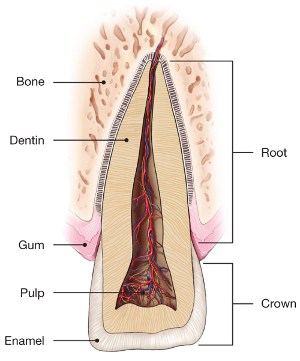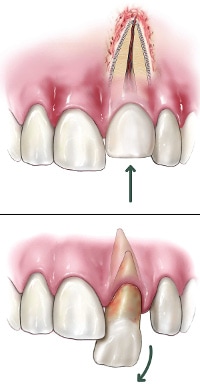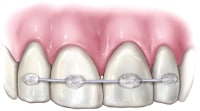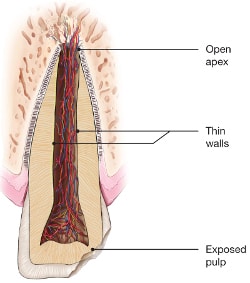Silverdale Dental Center is proud to offer our community comprehensive care
Your restoring dentist will help you create a customized treatment plan designed with consideration of your individual needs and priorities. Sometimes these treatment plans may include a need for specialty services including a periodontist, often referred to as a gum specialist, or an endodontist, a dentist who specializes in more complex root canal needs.
What is Endodontic Treatment?
 “Endo” is the Greek word for “inside” and “odont” is Greek for “tooth.” Endodontic treatment involves the inside of your tooth. Inside your tooth, under the white enamel and a hard layer called the dentin, is a soft tissue called pulp. It contains blood vessels, nerves and connective tissue, and creates the surrounding hard tissues of the tooth during its development.
“Endo” is the Greek word for “inside” and “odont” is Greek for “tooth.” Endodontic treatment involves the inside of your tooth. Inside your tooth, under the white enamel and a hard layer called the dentin, is a soft tissue called pulp. It contains blood vessels, nerves and connective tissue, and creates the surrounding hard tissues of the tooth during its development.
The pulp extends from the crown of your tooth to the tip of the roots, where it connects to the tissues surrounding the root. It’s vitally important during your tooth’s growth and development, however, once your tooth is fully mature it can survive without the pulp; your tooth continues to be nourished by the tissues surrounding it.
Who performs endodontic treatment?
All dentists, including your general dentist, received training in endodontic treatment in dental school. General dentists can perform endodontic procedures along with other specialized dental procedures, but often they refer patients needing more extensive endodontic treatment to endodontists.
Endodontists are dentists with special training in these procedures, and provide only endodontic services in their practices. They’ve completed dental school and an additional two or more years of advanced training in endodontics. You can feel confident visiting an endodontist for anything from routine to difficult and very complex endodontic procedures, including endodontic surgery. Endodontists also are experienced at finding the cause of oral and facial pain that has been difficult to diagnose.
Root Canals
What happens during root canal treatment? Learn more about this quick, comfortable procedure that can relieve your pain and save your natural tooth.
 There’s no need to be worried if your dentist or endodontist prescribes a root canal procedure to treat a damaged or diseased tooth. Millions of teeth are treated and saved this way each year, relieving pain and making teeth healthy again.
There’s no need to be worried if your dentist or endodontist prescribes a root canal procedure to treat a damaged or diseased tooth. Millions of teeth are treated and saved this way each year, relieving pain and making teeth healthy again.
Endodontic treatment is nothing to be nervous about. It’s very similar to a routine filling and can usually be completed in one or two appointments, depending upon the condition of your tooth and your personal circumstances. Getting a root canal is relatively painless and extremely effective. You’ll be back to smiling, biting and chewing with ease in no time.
Saving the natural tooth with root canal treatment has many advantages:
- Efficient chewing
- Normal biting force and sensation
- Natural appearance
- Protects other teeth from excessive wear or strain
Endodontic Retreatment
With proper care, you’ll keep teeth that have had root canal treatment for a lifetime, but it’s possible for those teeth to heal improperly, becoming painful or diseased months or even years after treatment. If this happens to your treated teeth you have a second chance to save the tooth with retreatment. An additional procedure may be able to diminish dental pain or discomfort and promote healing. If you suspect a tooth that had a prior root canal requires retreatment, visit your dentist or endodontist for evaluation.
As with any dental or medical procedure, it’s possible your tooth won’t heal as expected after initial treatment for a variety of reasons, including:
- Narrow or curved canals were not treated during the initial procedure.
- Complicated canal anatomy went undetected in the first procedure.
- The placement of the crown or other restoration was delayed following the endodontic treatment.
- The restoration did not prevent salivary contamination to the inside of the tooth.
A new problem can also jeopardize a tooth that was successfully treated, such as:
- New decay can expose the root canal filling material to bacteria, causing a new infection in the tooth.
- A loose, cracked or broken crown or filling can expose the tooth to new infection.
- A tooth sustains a fracture.
During retreatment, the endodontist will reopen your tooth and remove the filling materials that were placed in the root canals during the first procedure. The endodontist then carefully examines the tooth, looking for additional canals or new infection. The endodontist then removes any infection, cleans and shapes the canals, and places new filling materials. The opening is then sealed with a temporary filling. Once the tooth heals, a new crown or other restoration is placed on the tooth to protect it.
Endodontic Surgery
 It’s possible that a non-surgical root canal procedure won’t be enough to save your tooth and that your endodontist will recommend surgery. Endodontic surgery can be used to locate small fractures or hidden canals previously undetected on X-rays during the initial treatment. Surgery may also be needed to remove calcium deposits in root canals, or to treat damaged root surfaces or the surrounding bone of the tooth.
It’s possible that a non-surgical root canal procedure won’t be enough to save your tooth and that your endodontist will recommend surgery. Endodontic surgery can be used to locate small fractures or hidden canals previously undetected on X-rays during the initial treatment. Surgery may also be needed to remove calcium deposits in root canals, or to treat damaged root surfaces or the surrounding bone of the tooth.
There’s no need to worry about surgery if your endodontist prescribes this additional measure. Advanced technologies like digital imaging and operating microscopes allow these procedures to be performed quickly, comfortably and successfully.
There are many surgical procedures that can be performed to save a tooth. The most common is called an apicoectomy, or root-end resection, which may be needed when inflammation or infection persists in the bony area around the end of your tooth after a root canal procedure.
Your endodontist performs this microsurgical procedure by first making you comfortable with local anesthesia. They will then open the gum tissue near the tooth to see the underlying bone and remove any inflamed or infected tissue, and they will also remove the end of the root. A small filling may be placed to seal the end of the root canal and a few stiches or sutures are placed to help the tissue heal. In the next few months, the bone will heal around the end of the root. Most patients return to their normal activities the next day. Postsurgical discomfort is generally mild.
Traumatic Dental Injuries
Traumatic dental injuries often occur as a result of an accident or sports injury. The majority of these injuries are minor, such as chipped teeth. It’s less common to dislodge your tooth or have it knocked completely out, but these injuries are more severe. Treatment depends on the type, location and severity of each injury. Regardless of the extent of the injury, your tooth requires immediate examination by a dentist or an endodontist. Sometimes, your neighboring teeth suffer an additional, unnoticed injury that can only be detected by a thorough dental exam.
Endodontists specialize in treating traumatic dental injuries and with their advanced skills, techniques and technologies they often can save injured teeth. If you have a cracked or injured tooth, find an endodontist near you right away. Most endodontists offer tremendous flexibility in accommodating emergency cases, including weekends in some instances. You’ll have relief from your pain and likely save your tooth, so act as quickly as possible.
How will my injury be treated?
Chipped or Fractured Teeth
 If you’ve chipped or fractured your tooth’s crown, it can likely be repaired either by reattaching the broken piece or by putting a tooth-colored filling in place. If a significant part of your tooth crown is broken off, an artificial crown or “cap” may be needed to restore it.
If you’ve chipped or fractured your tooth’s crown, it can likely be repaired either by reattaching the broken piece or by putting a tooth-colored filling in place. If a significant part of your tooth crown is broken off, an artificial crown or “cap” may be needed to restore it.
When the pulp is exposed or damaged after a crown fracture, root canal treatment may be needed. These injuries require special attention. If breathing through your mouth or drinking cold fluids is painful, bite on clean, moist gauze or cloth to help relieve symptoms until reaching your dentist’s office. Never use topical oral pain medication (such as Anbesol®) or ointments, or place aspirin on the affected areas to eliminate pain symptoms.
Injuries in the back teeth, such as fractured cusps, cracked teeth require root canal treatment and a full coverage crown to restore function your tooth if the crack extends into the root. More seriously injured split teeth may require extraction.
Dislodged (Luxated) Teeth
 During an injury, a tooth may be pushed sideways, out of or into its socket. Your endodontist or general dentist will first reposition and stabilize your tooth. Root canal treatment is usually needed for permanent teeth that have been dislodged and should be started several days following the injury. Medication may be put inside your tooth as part of the root canal treatment; once treatment is complete and has been deemed successful a permanent root canal filling or crown will be put in place at a later date.
During an injury, a tooth may be pushed sideways, out of or into its socket. Your endodontist or general dentist will first reposition and stabilize your tooth. Root canal treatment is usually needed for permanent teeth that have been dislodged and should be started several days following the injury. Medication may be put inside your tooth as part of the root canal treatment; once treatment is complete and has been deemed successful a permanent root canal filling or crown will be put in place at a later date.
Children ages 12 and under may not need root canal treatment since their teeth are still developing. New research indicates that stem cells present in the pulp of children’s teeth can be stimulated to complete root growth and heal the pulp following injuries or infection. When a child’s tooth is injured, an endodontist or dentist will monitor the healing carefully and intervene immediately if any unfavorable changes appear. Multiple follow-up appointments are likely to be needed.
Knocked-Out (Avulsed) Teeth
 If one of your teeth is completely knocked out of your mouth, see an endodontist or dentist immediately! Time is of the essence and if you receive treatment quickly, preferably within 30 minutes, there is a chance to save your tooth.
If one of your teeth is completely knocked out of your mouth, see an endodontist or dentist immediately! Time is of the essence and if you receive treatment quickly, preferably within 30 minutes, there is a chance to save your tooth.
Handle a knocked-out tooth very carefully and don’t touch the root surface. Following a few important steps will help increase the likelihood of saving your tooth. Your endodontist or dentist will evaluate the tooth, place it back in its socket and examine you for any other dental and facial injuries. A stabilizing splint will be placed for the next few weeks. Depending on the stage of root development, your dentist or endodontist may start root canal treatment a week or two later.
 Depending on the length of time your tooth was out of your mouth and how it was stored before receiving treatment, it may be necessary to discuss other treatment options with your dentist or endodontist.
Depending on the length of time your tooth was out of your mouth and how it was stored before receiving treatment, it may be necessary to discuss other treatment options with your dentist or endodontist.
Root Fractures
 A traumatic injury to your tooth may also result in a horizontal root fracture. The location of the fracture determines the long-term health of your tooth. The closer a fracture is to the root tip, the better the chances of success and long-term health; fractures closer to the gum line are more debilitating for your tooth. Sometimes, stabilization with a splint is required while the tooth heals.
A traumatic injury to your tooth may also result in a horizontal root fracture. The location of the fracture determines the long-term health of your tooth. The closer a fracture is to the root tip, the better the chances of success and long-term health; fractures closer to the gum line are more debilitating for your tooth. Sometimes, stabilization with a splint is required while the tooth heals.
Do traumatic dental injuries differ in children?
 Chipped primary (baby) teeth can be esthetically restored. Dislodged primary teeth can, in rare cases, be repositioned. However, primary teeth that have been knocked out typically should not be replanted because it may cause further and permanent damage to the underlying permanent tooth that is growing inside the bone.
Chipped primary (baby) teeth can be esthetically restored. Dislodged primary teeth can, in rare cases, be repositioned. However, primary teeth that have been knocked out typically should not be replanted because it may cause further and permanent damage to the underlying permanent tooth that is growing inside the bone.
Children’s permanent teeth that are not fully developed at the time of the injury need special attention and careful follow up, but not all of them will need root canal treatment. In an immature permanent tooth, blood supply to the tooth and stem cells in the region may enable your dentist or endodontist to stimulate continued root growth.
Endodontists will do all that is possible to save the natural tooth and have the knowledge and skill to treat incompletely formed roots in children so that, in some instances, the roots can continue to develop. Look to our specialists for information and expertise when your child is the victim of dental trauma.
Will the tooth need any special care or additional treatment?
Factors that affect the long-term health of your tooth after an injury include: the nature of the injury, the length of time from injury to treatment, how your tooth was cared for after the injury, and also your body’s response. Getting treatment as soon as possible is very important with dislodged or knocked-out teeth in particular, in order to prevent root resorption.
Resorption occurs when your body, through its own defense mechanisms, begins to reject your own tooth in response to the traumatic injury. Following an injury, you should return to your dentist or endodontist to have the tooth examined and/or treated on a regular basis for up to five years to ensure that root resorption is not occurring and that surrounding tissues continue to heal. Unfortunately, some types of resorption are untreatable.

